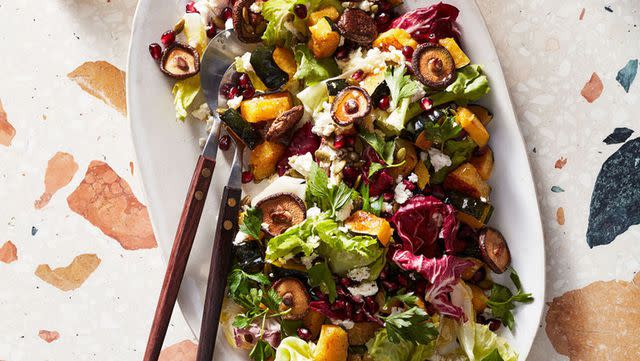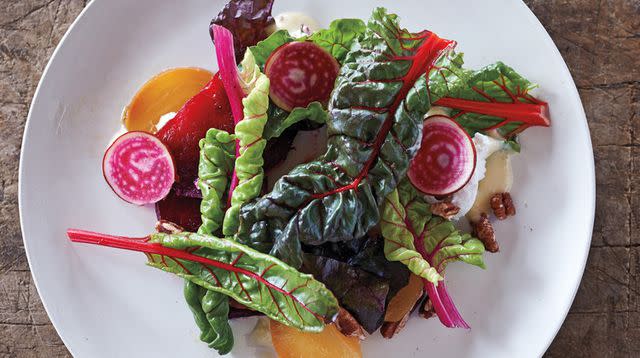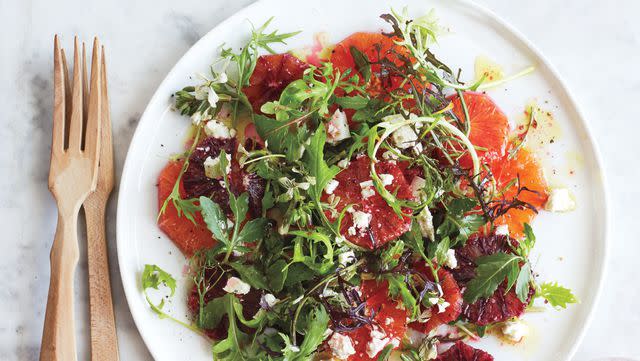Thomas Joseph’s Tips for Creating Colorful, Satisfying Winter Salads You’ll Actually Be Excited to Eat
Making a fresh, inspiring winter salad is easy once you get the formula down.
I’m not someone who thinks salad is a side dish, an afterthought, or something you can only eat in the summer. For me, salads are a chance to be creative with produce, to embrace color on the plate, and to eat more vegetables. The key to a delicious, tempting salad is to keep it interesting, seasonal, and most of all, tasty. Start with these basic tips and you’ll be well on your way to building your perfect salad for lunch, dinner, or anywhere in between.

Related: Quick Salad Recipes That Make Excellent Dinners on Busy Weeknights
3 Essential Elements Every Salad Needs
When choosing ingredients for a salad, there are three main elements to consider: flavor, texture, and color.
Flavor
The more components you incorporate into your salad, the more complex your flavor profile will be. Include as many of these flavor options as you like:
Something acidic or tart. Ideas include citrus juice, vinegar in the dressing, or grapefruit segments in the salad.
Something savory. My favorite way to add savory notes is by mixing cooked elements into the salad.
Something fresh (like herbs or citrus zest) or briny (like capers or olives) to bring the salad to life.
A touch of sweetness. Sweet vegetables (like beets), dried fruit, candied nuts, or a little honey in the dressing are all great options.
Texture
This element often gets overlooked, but your salad will be boring without variation and texture, no matter how flavorful it is. When composing a salad, aim for:
Something crunchy. This is pretty easy, and often comes from fresh lettuce, radicchio, or other greens, but also cucumbers (my favorite), carrots, fennel, or cabbage.
Something crispy. A bit different from the crunch of vegetables, crispiness might come from toasted seeds, nuts, or breadcrumbs, crispy bacon or potatoes, or frizzled shallots.
Something soft and unctuous. There are many possibilities here, like adding slices of roasted acorn squash, avocado, jammy eggs, or a favorite soft cheese.

Color
Color makes everything more interesting, because we all eat with our eyes. There’s no reason to limit yourself to just greens—or even any green at all. Add some color with a variety of in-season vegetables, like golden beets, purple carrots, orange squash, red radicchio, or deeply colored olives.
Rethink Lettuce
Experimenting with your go-to leafy greens is an easy way to get out of a salad rut. If you generally use romaine or always reach for a bag of baby spinach, consider other options like endive, frisée, and various types of radicchio, which are at their best in the winter and add a touch of bitterness to wake up your palette. Or, swap the leafy greens entirely for sturdier vegetables you can cook, blister in the oven, or grill—like cabbage or cauliflower—and turn that into a salad.
Whether the salad is lettuce-based or not, I love to add handfuls of tender herbs—like parsley, cilantro, or mint—for fresh, bright flavor.
Combine Raw and Cooked Elements
One of my favorite ways to make a salad interesting is to use a combination of raw and cooked ingredients. You might think salads are all about raw produce, but consider the Niçoise salad, which includes cooked tuna, hard-boiled eggs, boiled potatoes, and green beans, along with butter lettuce and tomatoes. Cooked ingredients can be anything from proteins, like chicken or fish, to cooked vegetables, like potatoes, beets, parsnips, or onions.
Use Dressing for Balance
Homemade dressings are a great way to balance the flavor of a salad: Complement sweet ingredients with an acidic dressing, temper the bitterness of chicories with a sweet dressing, add punch with mustard, and so on. (Generally, I like a dressing that’s more on the acidic side, since it helps to stimulate your appetite.)
Making your own dressing is easy. At its most basic, it’s oil and vinegar—but which oil and which vinegar you use makes all the difference. If you want to eat more salad, stock up on ingredients to make a variety of dressings.
Related: 26 of Our Tastiest Homemade Salad Dressing Recipes
There are three basic elements to a dressing:
Vinegar: I like vinegar and have a good selection in my pantry, including sherry vinegar, white balsamic vinegar, and different wine vinegars. Sometimes I use citrus juice in place of vinegar in my dressing—lemon is an obvious choice, but consider using freshly squeezed orange juice for a sweeter option.
Oil: Extra-virgin olive oil is my go-to, but I also use avocado, walnut, and pumpkin seed oil.
Mustard: Mustard is a game changer, and not just for salad dressing. I have a lot of different mustards in my kitchen—including grainy mustard and Dijon—and adding a generous spoonful to a dressing can transform it.
Supplement these basics with other ingredients, such as citrus zest, minced shallot, fresh herbs, honey, maple syrup or sugar, and, of course, salt and freshly ground black pepper.
And if you begin to tire of the classic vinaigrette, try substituting the oil and mustard with sour cream or yogurt. Add a little lemon juice, some herbs, and minced shallot, you'll be on your way to a creamy, ranch-like dressing that's far better than any store-bought variety.
Turning a Salad Into a Meal
Now that you have all the elements for putting together a winter salad that tastes as good as it looks, here are some tips for turning that salad into a meal.
Add Protein
Adding protein makes a salad dinner-ready. Salmon, chicken, shrimp, even steak, are all great options. Here’s my secret: I use a lot less protein for a dinner salad than I would if I was sitting down to a traditional meat-starch-vegetable meal. A little protein can go a long way when paired with a salad full of flavors and textures. Another bonus? You can prepare the protein ahead of time, cooked simply with just some salt, pepper, and maybe a drizzle of lemon and olive oil, and serve it at room temperature.
Incorporate Grains
Another way to make your winter salad more substantial is to make it a grain salad. Cooked grains, such as couscous, farro, or barley, also bring flavor and texture. I usually add a handful of chopped fresh herbs to the grains or enhance them with toasted nuts, seeds, and spices.
Sweeten the Deal
There are many options for adding sweetness to your salad, everything from sliced apples or pears to other fresh and dried fruits. If you’re like me and aren’t big on adding fruit to savory salads, a pinch of sugar or spoonful of honey in the dressing can add that touch of sweetness a salad needs for balance.

Add Nuts, Cheese, and Other Essentials
In January, many people are leaning into healthy eating, but that doesn’t mean you should skip adding more indulgent ingredients like nuts and cheese to your salad. My suggestion is to choose the right ingredients and use a little less if needed.
With cheese, choose aged or other flavorful versions, that way you can use a lot less than you would with a milder cheese.
Toasting nuts amps up their flavor. Chop them up so a little goes a long way.
Make the Most of Winter Produce
Roasting, broiling, and even grilling concentrates flavors and caramelizes vegetables. Even if your tomatoes or bell peppers aren’t the most flavorful, you can enhance them with cooking to add sweetness, color, and a depth of flavor to your winter salad.
Read the original article on Martha Stewart.

